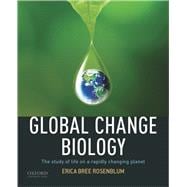Global Change Biology is available in e-book format only. Print-on-demand can be provided for orders where print is specified.
Bree Rosenblum's Global Change Biology provides a comprehensive introduction to the field of Global Change Biology and a roadmap for structuring Global Change Biology courses, a burgeoning field of biological study. The first of its kind, Rosenblum goes beyond the narrow focus of existing texts, which tend to focus on climate only, by offering a conceptionally integrated approach to understanding how humans have impacted life on Earth. The textbook guides students to think about change across spatial and temporal scales and fills a unique niche of integrating ecological and evolutionary perspectives throughout.
The conceptual arc of the textbook is organized around four fundamental learning objectives that traverse the past, present, and future. Students will explore: a) the complex history of planetary change, b) the impact of contemporary stressors across biological levels, biomes, and the tree of life, c) the dynamic interactions and responses of living systems to planetary change, and d) the opportunities for maintaining resilient ecosystems in a changing world. Enrichment features include Core Concepts boxes reviewing foundational material, Meet the Data boxes providing direct experience interpreting global change biology data, and Taking a Closer Look providing an opportunity to evaluate multifaceted biological responses in complex systems. Pre- and post- assessment tools like The Blank Page and reflection questions throughout, encourage students to reflect, self-assess, and deepen their learning.
The primary intended audience for Global Change Biology is upper division undergraduate students who are ready to apply key concepts in ecology and evolution to the Global Change Biology theme area and develop a more analytical and integrative skill set as scientists. However, the textbook has crossover power to engage other audiences and provide a roadmap for developing courses to inform and inspire students about the study of life on a rapidly changing planet.








